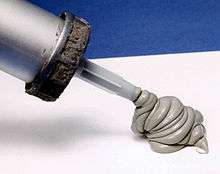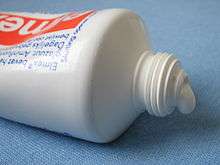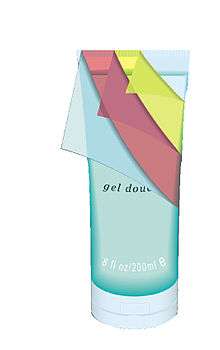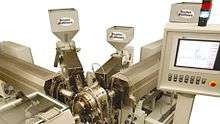Tube (container)



A tube is a soft squeezable container which can be used for thick liquids such as adhesive, caulking, ointment, and toothpaste. Basically, a tube is a cylindrical, hollow piece with a round or oval profile, made of plastic, paperboard, or aluminum. Both ends of this tube are treated differently during the manufacturing process and filling. In general, on one end of the tube body there is a round orifice, which can be closed by different caps and closures. The orifice can be shaped in many different ways. Plastic nozzles in various styles and lengths are just one good example.
To attach caps and closures, in most cases a thread is tapped onto the opening structure. Furthermore, something all aluminium tubes have in common is that the other open end is folded several times after the contents have been added. The tube is thus hermetically sealed and nearly germ-free due to the high temperatures during the production process. Furthermore, it is possible to coat the inside of the tube with special coatings to prevent the material from reacting with the contents.
Tubes are not poured from liquid aluminium; they are produced by the process of impact extrusion. In this process, the tube body is extruded from a small piece of aluminium with the round shape of a coin.
Unlimited printing designs can be applied to the tube, thanks to the wet-in-wet offset printing method. Six tones can be printed with this printing procedure, which gives packaging designers great opportunities to express their creativity.
The filled content can be easily squeezed out by the pressure of two fingers. The main characteristic of aluminium tubes is the total separation of the contents from the surrounding atmosphere; therefore, such tubes are especially suitable for the packaging of highly perishable contents. Aluminium tubes are used as packaging technology for cosmetics, pharmaceuticals, food, and technical products.
Plastic Tubes : Tube containers can also be produced in plastic, most commonly PE. The use of plastic tubes is very popular for the storage of Cosmetics such as hand creams etc. and also some food stuffs. The plastic tube retains its shape after each "squeeze" unlike laminate tubes such as toothpaste tubes. Plastic tubes can also be highly decorated or have a special additive such as soft touch to make the tube more appealing during use or point of sale (POS).


Plastic tubes are produced using the extrusion process. A "sleeve" is first produced using a very specialised extrusion line. The "Sleeve" must be produced to a very high standard (for decoration purposes) and also to very tight tolerances as automated processes are required post the extrusion operation. Once the "sleeve" is produced the tube head is fitted using an automated heading machine. Tube printing using complex and specialised printing machines such as silk screen printing applies the desired decoration. The open tubes are then most likely packed and despatched to another facility for filling and sealing.
The growth of multi-layer plastic tubes has been significant over the last couple of years due to the "barrier" properties of the tube to enable a wider range of products such as food to be stored in them.
Invention
John Goffe Rand, an American portrait painter, invented the squeezable metal tube in 1841 for storing paints.[1]
Shipping tubes
Other tubes are made of paperboard or corrugated fiberboard for shipping posters or long items. The FedEx "tube" shipping container is actually an extruded triangle.[2][3]
See also
Notes
- ↑ painting.about.com/od/artsupplies/ig/Winsor-Newton-Factory/invention-paint-tube.htm
- ↑ FedEx Tube, fedex.com, retrieved March 2, 2010
- ↑ GIZMORAMA: LIFE IN THE TECH AGE, United Press International, Dec 18, 2001, archived by HighBeam Research, retrieved March 2, 2010
References
- Yam, K. L., "Encyclopedia of Packaging Technology", John Wiley & Sons, 2009, ISBN 978-0-470-08704-6
- Soroka, W, "Fundamentals of Packaging Technology", IoPP, 2002, ISBN 1-930268-25-4
External links
-
 Media related to Tubes (packaging) at Wikimedia Commons
Media related to Tubes (packaging) at Wikimedia Commons